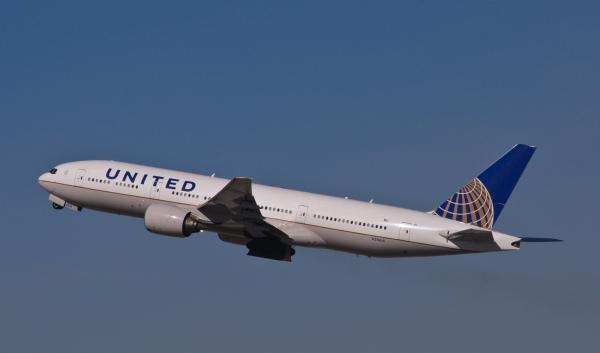A United flight (UA-31) bound for Newark (New Jersey) from Munich (Germany) was safely diverted to London Heathrow Airport after multiple passengers complained of feeling lightheaded and unwell.
The Aviation Herald adds “sick with nausea” to the list of symptoms and a twitter user who is a presumptive passenger Olgierd Swida @olgierd writes “#UA31 from MUC to ERW had to land in LHR, as some crew and few passengers got sick after food was served.”
Here are additional twitter posts from passenger Pete Teoh describing the arrival of emergency medical personnel onto the plane:


One individual was taken off the plane by EMS and the rest were formally assessed, ultimately booked into hotels and rerouted to their final destinations. Other accounts on social media describe riders as wearing oxygen masks, though the photos published so far on such sites don’t demonstrate this to be the case.
By all reports, an investigation into the cause of the complaints is underway and the travelers are doing well.
So, what could cause a number of people at the same time to feel lightheaded without a sense of well-being?
Hypoxia is the most likely trigger, but what prompted it? Which of the four types of hypoxia--individually or in combination? (See here).
Oxygen deprivation is influenced by the altitude, rate of ascent, cabin pressurization (or lack thereof), the human body’s capacity to withstand such stressors, rapid acceleration etc. Aviation physiology is quite complex.
Size of the aircraft matters when a leak or depressurization arises. A fighter jet will not compensate as sufficiently as a commercial airliner. Depending if the compromise is slow or abrupt determines how adversely occupants are affected.
Fighter pilots are routinely studied by the U.S. Air Force and due to the very serious, catastrophic potential of pilot hypoxia it is not uncommon for fighter jets to be grounded just like this commercial UA-31 one will be to identify the problem. At a certain point which can vary between individuals, G-force induced loss of consciousness (G-LOC) can lead to crashes. With hypergravity states these pilots endure, the blood to the brain can retreat and flow outward while pooling toward the lower extremities. In stagnant hypoxia, there is a circulatory transport issue where the impediment is in blood delivery of oxygen to the cells. The culprit tends to be G-forces (e.g. shock, heart failure).
To learn more about methods to enhance their tolerance and the use of special compression suits designed to redirect blood flow toward the upper body and head—since the brain does not fare well without oxygen if even momentarily, review Fighter Pilot Hypoxia Isn’t Just F-35 Issue.
Altitude issues impact people differently--- this contributes to the type hypoxic hypoxia which is also most common in flying. To understand how vulnerable even the most legendary of aerospace explorers can be, see At High Altitude with Buzz Aldrin which addresses the famous astronaut’s recent bout of altitude sickness that warranted medical evacuation from the South Pole. In Fly Me to the Moon, But Hold the Altitude Sickness I delve further into high altitude illnesses, prevention and management. With the earliest signs, typically moving to lower altitude prompts significant improvement.
According to the Federal Aviation Administration (FAA), any individual flying above 12,000 feet in an unpressurized aircraft without supplemental oxygen is at risk of hypoxia. When oxygen levels are too low or absent, the body’s tissues, blood and cells struggle to maintain normal function. The brain and nervous system are particularly susceptible to such shifts. It occurs when there is a failure in the pressurized system— sometimes slow, other times abrupt— or due to errors in usage or impaired oxygen support mechanisms.
Human factors like alcohol or medication intake as well as level of exertion, fatigue and low blood sugar can exacerbate things too. This explains why in a more mildly impaired aircraft not all passengers are unduly influenced. Histotoxic hypoxia is caused by any interference with a cell’s ability to use oxygen effectively. That’s why central nervous system depressants like alcohol can be problematic. Narcotics can further serve to suppress the respiratory drive.
Hypemic hypoxia results from any situation where blood won’t permit attachment of oxygen like in carbon monoxide (CO) poisoning. In this instance, contamination in the cabin of CO from a faulty system can compete with hemoglobin’s ability to acquire oxygen.
Though there are a number of symptoms associated with hypoxia and their progression is dangerous if not corrected, the fact all but one of the passengers of flight UA-31 were apparently well upon arrival supports the self-limiting nature of the problem and makes this conclusion the most likely.
Is food poisoning likely?
Given the published account of “sick with nausea” being among the complaints and the detail of signs appearing “after food was served,” improper food handling, contamination or foodborne pathogens must be considered.
The fact it appears everyone normalized upon landing or shortly thereafter goes against an ingested culprit. Accompanying symptoms like vomiting, diarrhea or abdominal pain were not disclosed which, if true, also lowers the possibility of a foodborne etiology. Such causes also tend to have a staggered pattern to their presentation, so the likelihood that multiple passengers simultaneously and immediately would become symptomatic then completely recover is low.
In conclusion
Hopefully, the investigation will be fruitful and determine the source of the concern so the situation won't be repeated.




